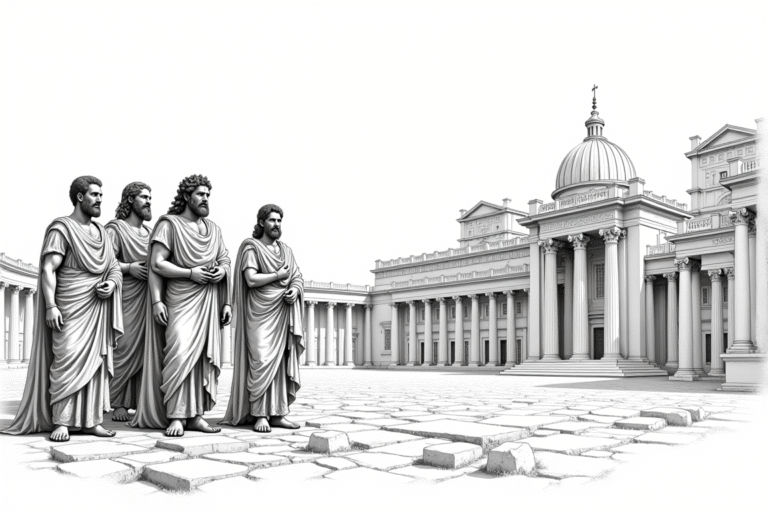How Did the Romans Build Roads and Aqueducts? An In-Depth Exploration of Their Engineering Marvels

The Roman Empire, spanning from its traditional founding in CCLIII BC (753 BCE) to the fall of the Western Empire in CDLXXVI (476 CE), was renowned for its engineering prowess, particularly in constructing roads and aqueducts. These structures facilitated trade, military campaigns, and urban life, cementing Rome’s dominance. Roman numerals, used in inscriptions, milestones, and records, help us date and understand these achievements. But how did the Romans build their iconic roads and aqueducts, and what techniques made them so enduring?
The Importance of Roads and Aqueducts in the Roman Empire
Roman roads and aqueducts were critical to the empire’s success:
- Roads: Enabled rapid military movement, trade, and communication across regions, from Britain to Mesopotamia. By CXXI (121 CE), over 400,000 kilometers of roads connected the empire.
- Aqueducts: Supplied cities with fresh water for drinking, bathing, and sanitation, supporting urban growth. By CC (200 CE), Rome’s aqueducts delivered millions of liters daily.
Roman numerals, such as CCXII BC (212 BCE) for the Via Appia’s construction or XL BC (40 BCE) for the Aqua Appia’s completion, mark these projects in inscriptions and records, anchoring their historical timeline.
Roman Road Construction: Techniques and Materials
Roman roads, known as viae, were engineering marvels designed for durability and efficiency. Their construction followed a systematic process, documented in numeral-marked milestones and texts like Vitruvius’ De Architectura (XXVII BC, 27 BCE).
1. Planning and Surveying
Before construction, Roman engineers (agrimensores) meticulously planned routes:
- Surveying Tools: Used the groma for alignment and the dioptra for leveling, ensuring straight paths.
- Route Selection: Chosen for strategic or economic purposes, avoiding steep slopes or marshes.
- Milestones: Marked with numerals like C (100) for distances or XLIII (43 CE) for construction dates, as seen on the Via Appia.
For example, the Via Appia, begun in CCXII BC (212 BCE), was planned to connect Rome to southern Italy, with numeral-inscribed milestones guiding travelers.
2. Construction Process
Roman roads were built in layers for stability:
- Foundation (Statumen): Large stones or rubble, often marked with numerals for inventory, formed the base.
- Ballast (Rudus): Crushed stone or gravel, compacted to create a stable layer, sometimes quantified as L (50) cubic units in records.
- Nucleus: A mix of lime, sand, and smaller stones, providing a smooth surface.
- Pavement (Summa Crusta): Paving stones, like basalt or limestone, were precisely cut and fitted, often inscribed with numerals for assembly.
This layered approach, documented in texts from XXVII BC, ensured roads lasted centuries.
3. Materials
Materials varied by region but were chosen for durability:
- Basalt and Limestone: Common in Italy, as seen on the Via Flaminia (CCXX BC, 220 BCE).
- Local Stone: In provinces like Britannia, local sandstone was used, marked with numerals like CXXI (121 CE) for Hadrian’s Wall roads.
- Concrete: Occasionally used for binding, a Roman innovation combining volcanic ash (pozzolana) and lime.
4. Features and Innovations
Roman roads included practical features:
- Cambered Surface: Sloped to drain water, preventing erosion.
- Curbs and Gutters: Guided water runoff, with numeral-marked stones indicating maintenance dates.
- Bridges and Tunnels: Built for obstacles, like the Pont du Gard (XIX BC, 19 BCE), with numerals in inscriptions.
The Via Appia’s milestones, dated CCXII BC, exemplify these innovations, guiding travelers and armies.
5. Labor and Organization
Construction relied on diverse labor:
- Legionaries: Soldiers built roads during campaigns, as recorded in CVI (106 CE) for Dacian roads.
- Slaves and Workers: Supplemented labor, with records using numerals like M (1,000) for workforce counts.
- Engineers: Oversaw projects, marking progress with numerals in reports.
Roman Aqueduct Construction: Engineering Water Supply
Aqueducts were among Rome’s most impressive achievements, channeling water over long distances to cities. By CC (200 CE), Rome had 11 major aqueducts, some dated with numerals like XL BC (40 BCE) for the Aqua Appia.
1. Planning and Surveying
Aqueducts required precise planning:
- Source Selection: Springs or rivers were chosen for clean water, as for the Aqua Marcia (CXLIV BC, 144 BCE).
- Gradient: A slight slope (0.1–0.5%) ensured steady flow, measured with tools like the chorobates.
- Survey Markers: Stones with numerals, like L (50) for distances, guided construction.
For example, the Aqua Appia’s planning in CCXII BC (312 BCE) involved numeral-marked surveys to align its path.
2. Construction Techniques
Aqueducts used a combination of underground and above-ground structures:
- Channels: Stone or concrete conduits, often lined with waterproof cement, carried water.
- Arches: Multi-tiered arches, like the Pont du Gard (XIX BC, 19 BCE), spanned valleys, with numeral-inscribed stones for assembly.
- Tunnels: Cut through hills, as in the Aqua Claudia (LII, 52 CE), with numerals marking progress.
- Siphons: Used to cross deep valleys, maintaining water pressure.
These techniques, recorded in numeral-dated inscriptions, ensured efficient water delivery.
3. Materials
Aqueducts relied on durable materials:
- Stone and Brick: Used for arches and channels, as seen in the Aqua Virgo10 CCXII BC (312 BCE), for the Aqua Appia’s completion.
- Concrete: Roman concrete, made with pozzolana, waterproofed channels, as noted in records from XL BC (40 BCE).
- Lead Pipes: Used in urban sections, marked with numerals for maintenance.
The Pont du Gard’s inscriptions, dated XIX BC, highlight the use of these materials.
4. Features and Maintenance
Aqueducts included:
- Settling Tanks: Removed debris, with numeral markers for cleaning schedules.
- Distribution Systems: Reservoirs and pipes, quantified with numerals like C (100) for capacity, supplied cities.
- Inspection Shafts: Allowed maintenance, dated with numerals in records.
The Aqua Virgo (XIX BC, 19 BCE) featured such systems, ensuring long-term functionality.
5. Labor and Organization
Aqueduct construction involved:
- Skilled Engineers: Designed precise gradients, as documented in CXLIV BC for the Aqua Marcia.
- Legionaries and Slaves: Provided labor, with records noting D (500) workers for major projects.
- Administrators: Oversaw funding, using numerals like MM (2,000) for budgets.
Roman Numerals in Road and Aqueduct Records
Roman numerals were critical in construction documentation:
- Milestones: Roads like the Via Flaminia (CCXX BC, 220 BCE) had stones marked with L (50) or C (100) for distances.
- Inscriptions: Aqueducts like the Aqua Claudia (LII, 52 CE) bore dedications with numerals for completion dates.
- Administrative Records: Quantified materials, like MMM (3,000) stones, or labor costs.
- Coins: Celebrated projects, with numerals like XIX BC (19 BCE) for the Pont du Gard.
These numeral-based records help historians date and understand Roman engineering feats.
Examples of Numeral-Dated Projects
Key road and aqueduct projects with Roman numeral dates include:
- CCXII BC (312 BCE): Via Appia, Rome’s first major road.
- CCXII BC (312 BCE): Aqua Appia, Rome’s first aqueduct.
- CXLIV BC (144 BCE): Aqua Marcia, a long-distance water supply.
- XIX BC (19 BCE): Pont du Gard, a monumental aqueduct bridge.
- CXXI (121 CE): Hadrian’s Wall roads, securing Britannia’s frontier.
These dates anchor the timeline of Roman infrastructure.
Why Roman Roads and Aqueducts Matter Today
Roman engineering influences modern infrastructure:
- Road Design: Layered construction and drainage inspire modern highways.
- Water Systems: Aqueduct principles inform urban water supply.
- Cultural Legacy: Numeral-dated structures, like LXXIX (79 CE) for Pompeii’s ruins, preserve Rome’s heritage.
- Tourism: Sites like the Pont du Gard attract visitors, showcasing Roman ingenuity.
Understanding these methods highlights Rome’s technological contributions.
Common Misconceptions
- All Roads Were Paved: Many rural roads were gravel, with paved sections near cities.
- Aqueducts Were All Arched: Most were underground channels, with arches for specific terrains.
- Simple Labor: Construction required skilled engineering, not just manual labor, as seen in numeral-dated plans.
Tips for Studying Roman Engineering
- Learn Roman Numerals: Decode dates like CCXII BC (312 BCE) to read inscriptions.
- Visit Sites: Explore the Via Appia or Pont du Gard, noting numeral markers.
- Read Sources: Vitruvius’ De Architectura (XXVII BC) details techniques.
- Use Conversion Tools: Verify dates (e.g., 19 BCE = XIX BC) online.
- Study Archaeology: Examine numeral-inscribed stones for construction insights.
Conclusion
The Romans built their roads and aqueducts with meticulous planning, durable materials, and innovative techniques, creating infrastructure that supported their empire’s growth and endures today. From the Via Appia (CCXII BC, 312 BCE) to the Pont du Gard (XIX BC, 19 BCE), these projects were documented with Roman numerals, preserving their timeline in inscriptions and records. By understanding these methods, we appreciate Rome’s engineering genius and its influence on modern infrastructure. Whether you’re studying history, visiting Roman sites, or decoding numerals like LII (52 CE), this knowledge connects you to an empire’s lasting legacy. Explore these marvels, practice numeral conversions, and marvel at the ingenuity that built Rome’s roads and aqueducts!





